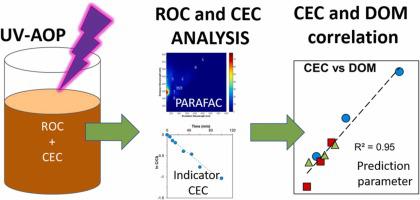当前位置:
X-MOL 学术
›
J. Hazard. Mater.
›
论文详情
Our official English website, www.x-mol.net, welcomes your feedback! (Note: you will need to create a separate account there.)
Development of dissolved organic matter-based indicators to understand the degradation of organic contaminants in reverse osmosis concentrate from potable reuse systems
Journal of Hazardous Materials ( IF 13.6 ) Pub Date : 2024-03-19 , DOI: 10.1016/j.jhazmat.2024.134060 Kiranmayi Mangalgiri , Zhiwen Cheng , Haizhou Liu
Journal of Hazardous Materials ( IF 13.6 ) Pub Date : 2024-03-19 , DOI: 10.1016/j.jhazmat.2024.134060 Kiranmayi Mangalgiri , Zhiwen Cheng , Haizhou Liu

|
Reverse osmosis (RO)-based treatment of municipal wastewater effluent allows for potable reuse, but this process generates reverse osmosis concentrate (ROC) that needs further treatment before disposal. This study investigated the application of UV-based advanced oxidation processes (AOPs) to degrade nine contaminants of emerging concern (CECs) from real ROC waste streams, using UV-only and UV-AOPs with hydrogen peroxide, free chlorine, and persulfate. Dissolved organic matter (DOM) in ROC was characterized using fluorescence excitation emission matrix data and analyzed by a four-component parallel factor (PARAFAC) analysis model. UV-only treatment showed considerable removal of CECs that displayed high values of quantum yields and molar absorption coefficients. UV-AOP treatment of ROC exhibited heavy scavenging of reactive species during CEC degradation. A probe-based approach established that hydroxyl radical was the dominant reactive species in all UV-AOPs. A kinetic analysis of PARAFAC components of DOM showed that the visible humic-like and protein-like components exhibited the higher reaction kinetics compared to UV humic-like and nutrient-like components. The strong linear correlation of protein-like component and seven of the nine CECs across multiple AOPs indicated that they have similar reactivity, enabling the establishment of chemical-reactivity based surrogates for prediction CEC fate in ROC wastes.
中文翻译:

开发基于溶解有机物的指标,以了解饮用水再利用系统中反渗透浓缩液中有机污染物的降解情况
对城市废水进行反渗透 (RO) 处理可实现饮用水再利用,但该过程会产生反渗透浓缩液 (ROC),在处置前需要进一步处理。本研究调查了基于紫外线的高级氧化工艺 (AOP) 的应用,使用纯紫外线和含有过氧化氢、游离氯和过硫酸盐的紫外线 AOP,降解真实 ROC 废物流中的九种新出现的污染物 (CEC)。使用荧光激发发射矩阵数据对 ROC 中的溶解有机物 (DOM) 进行表征,并通过四分量平行因子 (PARAFAC) 分析模型进行分析。仅紫外线处理显示 CEC 被大量去除,并显示出高值的量子产率和摩尔吸收系数。 ROC 的 UV-AOP 处理在 CEC 降解过程中表现出大量的活性物质清除作用。基于探针的方法确定羟基自由基是所有 UV-AOP 中的主要活性物质。对 DOM 的 PARAFAC 组分的动力学分析表明,与 UV 类腐殖质和类营养物组分相比,可见的类腐殖质和类蛋白质组分表现出更高的反应动力学。类蛋白质成分与多个 AOP 中 9 个 CEC 中的 7 个之间的强线性相关性表明它们具有相似的反应性,从而能够建立基于化学反应性的替代物来预测 ROC 废物中 CEC 的命运。
更新日期:2024-03-19
中文翻译:

开发基于溶解有机物的指标,以了解饮用水再利用系统中反渗透浓缩液中有机污染物的降解情况
对城市废水进行反渗透 (RO) 处理可实现饮用水再利用,但该过程会产生反渗透浓缩液 (ROC),在处置前需要进一步处理。本研究调查了基于紫外线的高级氧化工艺 (AOP) 的应用,使用纯紫外线和含有过氧化氢、游离氯和过硫酸盐的紫外线 AOP,降解真实 ROC 废物流中的九种新出现的污染物 (CEC)。使用荧光激发发射矩阵数据对 ROC 中的溶解有机物 (DOM) 进行表征,并通过四分量平行因子 (PARAFAC) 分析模型进行分析。仅紫外线处理显示 CEC 被大量去除,并显示出高值的量子产率和摩尔吸收系数。 ROC 的 UV-AOP 处理在 CEC 降解过程中表现出大量的活性物质清除作用。基于探针的方法确定羟基自由基是所有 UV-AOP 中的主要活性物质。对 DOM 的 PARAFAC 组分的动力学分析表明,与 UV 类腐殖质和类营养物组分相比,可见的类腐殖质和类蛋白质组分表现出更高的反应动力学。类蛋白质成分与多个 AOP 中 9 个 CEC 中的 7 个之间的强线性相关性表明它们具有相似的反应性,从而能够建立基于化学反应性的替代物来预测 ROC 废物中 CEC 的命运。



























 京公网安备 11010802027423号
京公网安备 11010802027423号